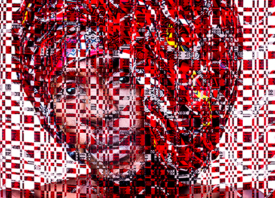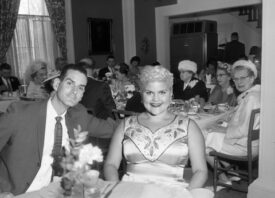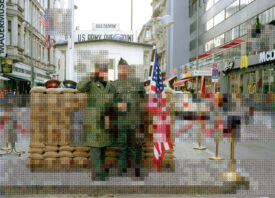Search this site
Photographer Uses Embroidery to ‘Pixelate’ Family Snapshots
Los Angeles–based photographer Diane Meyer’s photographs seem to be ordinary snapshots of family members and scenic outings until you notice that a technical glitch has left parts of the photo grossly pixelated. However, it’s far from a technical glitch—it’s Meyer’s handiwork. Tired of seeing her work on screen only, in 2011 Meyer began to embroider directly onto the surface of her photographs in swatches of color that look like pixels, albeit big, fuzzy ones, giving her photographs an undeniable physical presence. Meyer’s cross-stitches seem to toggle from thread to pixel and back again, reminding us of the imperfect natures of memory, photographic representation, and the omnipresent LED screen.
The series is called Time Spent that Might Otherwise Be Forgotten, and she starts with family snapshots from her childhood in rural New Jersey. Then Meyer cross-stitches over a face or a patch of landscape. The landscapes are both sensual and ironic, and their effect is to make you think about color as an abstract notion, whereas the family photos have an emotional heft as faces blur and break apart.
Much is said by the seen and the unseen, and it turns out that Meyer is ambivalent about the past. She says, “The images show naive, ideal moments—Christmas morning, posing with a new bicycle—when, in fact, our childhood was fairly traumatic.” Moreover, the work was prompted by Meyer’s worry over her brother, who languished in a coma recently after an accident. What if all he could remember of the past when he woke up was family photographs?
“The past and memories are something that slip away gradually and disappear,” Meyer says. Her embroidery obscures the faces of her family and chunks of her landscapes, even as it reveals something about the way photography arrests the past. The sensation is of seeing into three worlds at once—the glassily precise world of the photograph, the warm, homey world of embroidery, and the ambiguous non-world of the light-emitting diode and its basic building block, the pixel. Meyer’s work shows once again that photography can capture memories even as it obscures them.
This post was contributed by photographer Pelle Cass.












